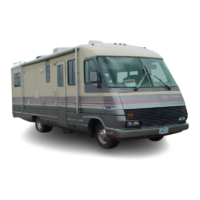Plumbing
Systems
and
Holding
Tanks
Draining the Holding Tanks
The holding tanks terminate in a valve arrange-
ment that permits draining each tank separately.
The valves are called knife valves. A blade
closes the opening in the sewer drain pipes. The
blade is connected to a T-handle and cable
assembly mounted in the utility compartment.
Pull the T-handle to release the contents
of
the
tank(s).
During self-containment use, the sewer line
is
securely capped to prevent leakage
of
waste
material onto the ground or pavement.
Do
not
pull
the
holding tllnk
knife
vllive open
when
the protective
CllP
is instlliled
on
the pipe.
Always drain the tank into an acceptable sewer
inlet
or
dump station.
Drain the holding tanks only when they are at
least
%-
full.
If
necessary, fill the tanks with
water to
%-full. This provides sufficient water to
allow complete flushing
of
waste material into
the sewer line.
Whenever possible, drain the holding tanks before
traveling. Waste water and sewage
in
the holding
tanks reduce the canying capacity
of
the motor
home. See the Motor
HOllle
LoOOing
chapter.
During extended or semi-permanent hookups to
sewage systems, waste materials will build up in
the tank and cause serious plugging
if
the tank
valves are continuously open. In these cases,
keep the valves closed until the tanks are
'/.-full,
and then drain into the sewage system.
The holding tank drain valve outlet
is
to be used
with a removable termination fitting that locks
onto the outlet with a clockwise twist. Clamp the
sewer drain hose to this fitting. A protective cap
should remain in place when you are not drain-
ing the tanks.
A WARNING
Holding tanks
are
enclosed sewer systems and
as
such must
be
drained into
an
approved dump station.
Both
black
and
gray water holding tanks must
be
drained
and
thoroughly rinsed regularly to prevent
accumulation
of
harmful or toxic materials.
.II
NOTE I
Local or state regulations may prohibit highway travel
unless the holding tank outlet
is securely capped.
To
drain
the
holding
tanks:
1.
Attach the sewer hose to the holding tank
outlet. Insert the end
of
the hose into the
sewer or dump station inlet, pushing it
firmly far enough into the opening to be
secure. In some cases, adapters may be
necessary or required between the line and
the inlet. Arrange the sewer hose so it
slopes evenly.
2. Drain the black water holding tank first.
Grasp the handle
of
the black water knife
valve (the large one) firmly and slide the
valve open with a quick, steady pull.
3. Allow enough time for the tank to drain
completely. Rinse and flush the tank
through the toilet. When the tank is empty,
push the handle in to close the valve. Run
enough water (up to five gallons or so) into
the tank to cover the bottom. This will aid
the break up
of
solid wastes, and reduce
"pyramiding"
of
waste material.
4. To drain the gray water tank, repeat the
steps above using the small knife valve.
This tank is drained last to aid in flushing
the outlets and hose. The gray water knife
valve may be left open in a semi-perma-
nent hookup.
S.
See the tank flush system instructions in
the next section
if
your recreational vehicle
is so equipped.
07-5
